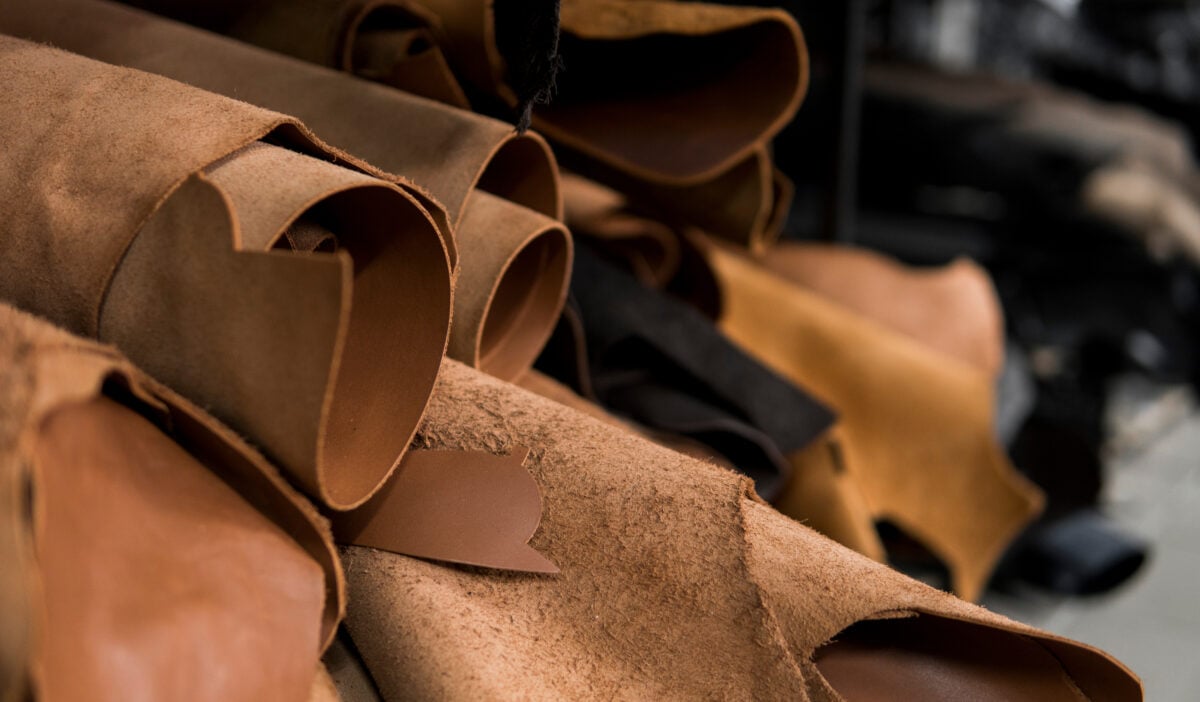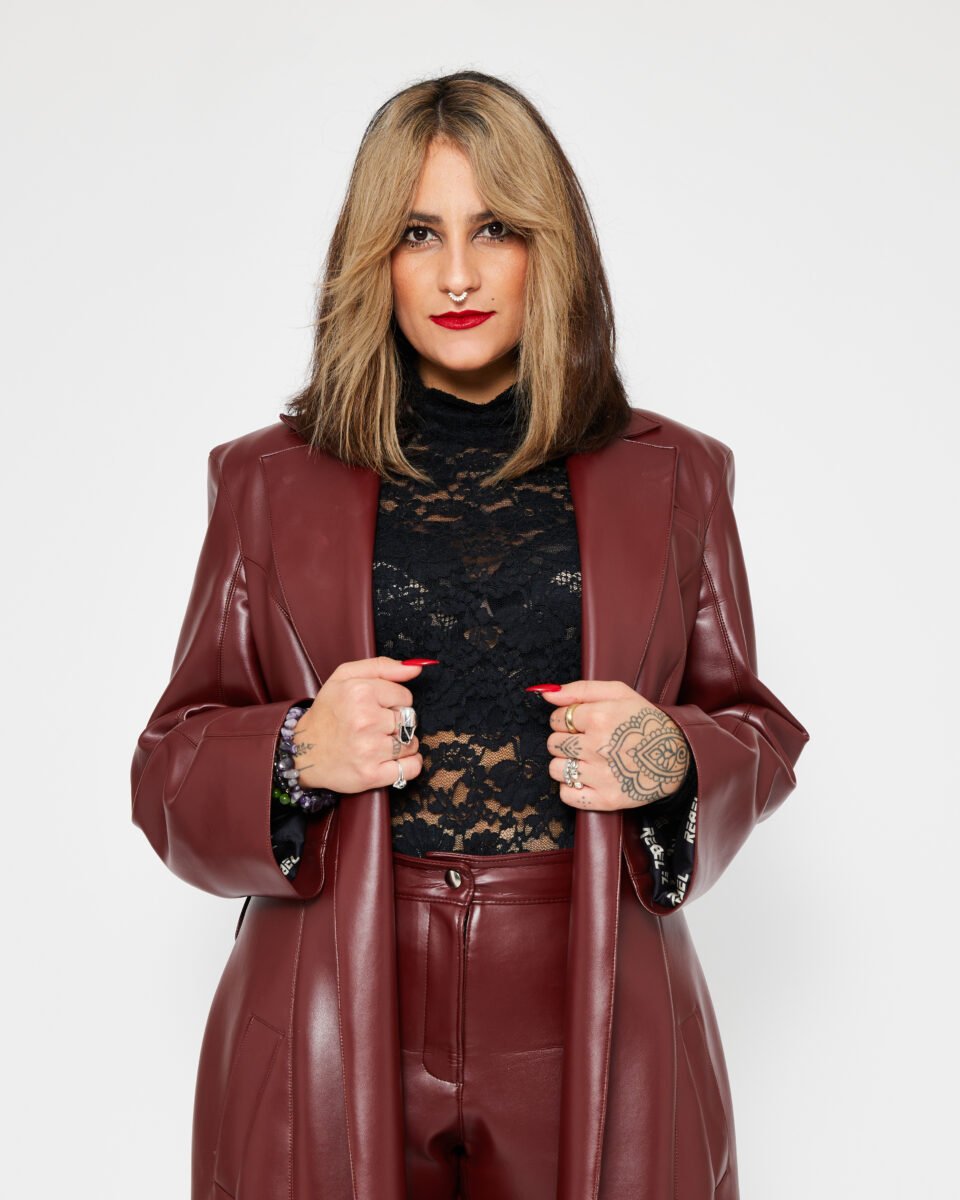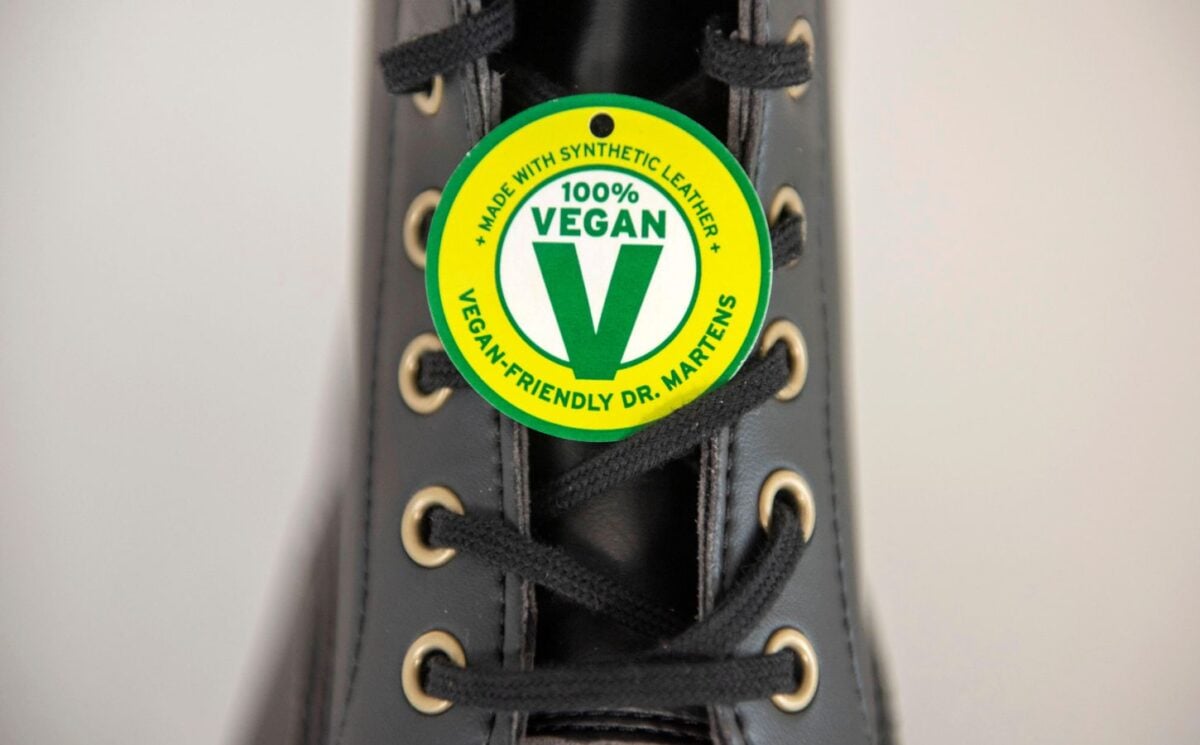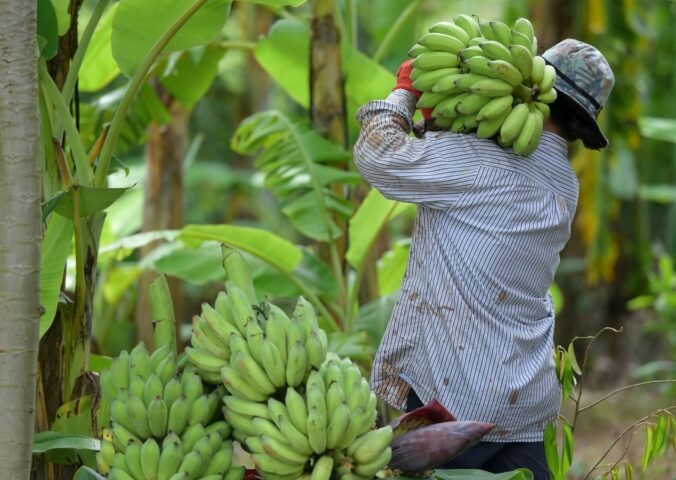Vegan leather is a game-changing innovation for those who avoid animal products. But what is vegan leather, exactly?
Recent advancements in materials and technology combined with growing consumer interest in sustainability mean that there is a wider variety of vegan leather options than ever before, and high-end fashion designers and high street labels alike are now championing these materials. It’s not just vegan brands that are using leather alternatives: it’s increasingly being adopted by mainstream fashion brands including Adidas, Ganni, Dr. Martens, and Gucci. While plant-based leather is not the rise, not all vegan leather alternatives are equally effective or sustainable.
Here’s everything you need to know about vegan leather in 2025, including what it is, what it’s made out of, and where this plant-based fashion trend might be heading next.
Read more: TfL’s New Sustainable Uniform Includes Vegan Leather Shoes
Why isn’t leather vegan?

Leather is tanned skin, and it isn’t vegan because it’s made from animals.
Leather mostly comes from cows, but it can also be from sheep, goats, horses, pigs, seals, alligators, and many other animals. Modern leather-making is lucrative, and contrary to popular belief, animal skins are co-products of the meat industry, not simply byproducts.
While traditional leather-making has been practiced by humans for thousands of years, most leather today is mass-produced. This creates tonnes of CO2-equivalent emissions and causes environmental damage, pollution, and human deaths, in addition to animal deaths.
According to a report by Textile Exchange, over 1.4 billion animals (nearly 20 percent of the entire human population at the time) were used to make 12.5 million tonnes of leather in 2020. And despite the rapidly worsening climate crisis, leather production is set to grow.
Farming animals – and cows, in particular – has a significant environmental impact. But turning animals’ skins into leather causes additional harm through its own emissions, the use of toxic chemicals during tanning, and the industry’s links to human rights violations of all kinds.
Is vegan leather sustainable?
Because farming cows is so bad for animals and the environment, it’s difficult to imagine a more resource-intensive, inefficient, and harmful material to make clothes out of. However, that doesn’t mean that all vegan alternatives are necessarily sustainable, or even practical.
For example, some vegan leather alternatives are made with polyvinyl chloride (PVC) or polyurethane (PU), which are plastic-based and derived from petroleum. Producing these plastics is also harmful to the environment, and recycling them is difficult, at best.
Fortunately, as the vegan leather sector grows, there is an increasing number of vegan leather alternatives that emphasize sustainability. Some, like coconut leather, are biodegradable, while others, like tea leather, involve the upcycling of otherwise wasted ingredients.
Many of these plastic-free leather alternatives also perform just as well as traditional leather in terms of water resistance, texture, appearance, and longevity. This makes them the more sustainable choice from production, during use, and right through to end-of-life and disposal.
Plastic-free vegan leather alternatives
London-based fashion designer Sarah Regensburger, the founder and director of namesake vegan brand Sarah Regensburger, told Plant Based News (PBN) that for her, “the point” of plant-based alternatives is to look as good as – or better than – traditional leather products.
“The consumer [whether] vegan or not should not see the difference but just buy a better product with less harm to the planet and the animals,” she said.
Regensburger founded her fashion company in 2019, and her designs have been worn by celebrities and artists like Lady Gaga, Taylor Swift, Rickey Thompson, and Mahalia.
Regensburger won Designer of the Year at PETA’s 2022 Fashion Awards, and she incorporates vegan-friendly materials like bamboo-based fur, and plant-based leather, into her designs. She specifically highlighted the need to win over non-vegans with these sustainable materials.
“Whenever I wear my Cactus Coat, people are interested; they love it,” said Regensburger. “Not because they are vegan but because it is innovative and better for the planet. We do not need to change the mind of the vegans but the non-vegans to purchase these products.”
Cactus leather

As mentioned by Regensburger, cactus leather is one of the go-to materials for her fashion brand. It is made from the mature leaves of the prickly-pear cactus, and the first company to make cactus leather – Desserto – exclusively uses organic and circular farming systems.
The final product is soft, durable, and partially biodegradable. Prickly-pear cacti require no herbicides or pesticides, and harvesting the mature leaves does not harm the plant. Furthermore, most of its modest water requirements are absorbed via atmospheric humidity. In contrast, a tote bag made from animal leather requires around 17,128 litres to produce.
Pineapple leather
Pineapple leather was first produced by the company Ananas Anam under the brand name Piñatex and has been used by huge international names like Nike, H&M, Hugo Boss, and Paul Smith, as well as various independent and high-end fashion designers like Regensburger.
As a product, pineapple leather is purely agricultural waste, meaning that it requires no extra land, water, or pesticides to produce. Each linear meter of Piñatex prevents the equivalent of 12 kg CO2 from being emitted, while the leather itself is strong, durable, light, and breathable.
“My Go-to leather alternatives are mainly cactus leather and pineapple leather; they have a very luxurious outlook, and I have been using them primarily for my last collections,” said Regensburger. “A lot of the plant-based leather alternatives are quite thick which makes it slightly more difficult to use on garments. This is why I love to use Cactus and Pineapple leather, they work incredibly well for clothing.”
Tea leather
Tea leather is a relatively new addition to the bio-leather space for 2025, and it was first produced by the Turkish company Wastea. The unique plant-based leather is up to 95 percent bio-based and is primarily made up of the stems, leaves, and buds leftover from manufacturing tea. Turkey notably produces millions of tons of tea each year, which makes these byproducts – typically burned or sent to landfill – ideal for a company like Wastea’s sustainable leather.
Mushroom leather

So-called “mushroom leather” is made of mycelium, which is actually a root-like structure of fungus. It’s incredibly sustainable and versatile, and in recent years, it has been used for everything from building houses to making surfboards, as well as durable vegan leather.
Bolt Threads is the most prominent brand in this space, and the Californian biotech startup supplies brands like Stella McCartney, Adidas, and Lululemon with sustainable “Mylo” leather. This material is vertically farmed and then customized for its intended purpose, be it a bag or a pair of shoes. Other key brands include MycoWorks and MycoFutures.
Rubber leather
Stella McCartney and Natural Fibre Welding (NFW) partnered to launch “MIRUM” in 2023, a rubber leather that combines natural rubber with various plant oils and waxes.
According to the brands, MIRUM is vegan, plastic-, fossil fuel-, and water-free, and combines virgin natural materials with upcycled agricultural waste streams for maximum sustainability. It’s ideal for softer products like accessories and shoes, as well as car interiors and seat linings.
Apple leather
Apple leather is produced using industry waste like skins and cores, and the leather itself features water resistance and a smooth texture. Italian brand Frumat sources its materials locally as an innovative solution to the unsustainability of traditional leather and the high quantity of apple waste in northern Italy. Apple leather is customizable and biodegradable.
Cork leather
Cork leather is made from the bark of the cork oak tree. Notably, harvesting the bark does not harm the tree, making it infinitely renewable – provided the harvesting process is carried out carefully, by experts, every nine or so years, in order to preserve forest health and longevity.
According to The Cork Company, harvested cork absorbs up to 10 times the average CO2 stored by unharvested cork. Vegan accessories brand Watson & Wolf has noted that for every ton of cork harvested, a cork forest absorbs approximately 70 tons of CO2 from the atmosphere. Cork leather itself is soft, flexible, and light, but also resists rot and abrasion.
Grape leather
Grape leather is made from the leftover grape skins, seeds, and stems from wine production. Italy’s VEGEA makes good use of the country’s approximately two million tons of grape waste produced each year to make its water-resistant, flexible, and sustainable vegan leather. While the final product is not entirely made of waste, it is an innovative and sustainable option.
Mango leather
Dutch company Fruitleather Rotterdam also upcycles food waste by turning leftover mangos into a durable vegan leather. This finished product has a smooth texture and can be used in a wide range of clothing and accessories, including fine items like wallets and handbags. Fruitleather Rotterdam even makes moleskin-style replaceable notebook covers.
Banana leather
Another company upcycling fruit waste in 2025 is Banofi, which transforms bananas into vegan leather. The company is based in India, which is both the largest producer of bananas and one of the primary producers and exporters of leather. After harvest, approximately 60 percent of banana biomass is left as waste, which means every single ton of usable fruit results in tons of unused material. Banofi turns this previously used material into luxury vegan leather.
Coconut leather
Indian brand Malai Biomaterials makes its vegan coconut leather, “Malai,” by fermenting bacterial cellulose from waste coconut water and combining this with upcycled fruit fibres. The finished product is naturally water-resistant and extremely flexible. Items made from Malai last up to eight years when properly cared for and are completely biodegradable.
Leaf leather
In 2024, the UK company Biophilica partnered with Sappi North America to launch an updated leaf leather product called “Treekind.” This version of leaf leather is 100 percent bio-based and home-compostable. The leaves themselves are gathered from London parks.
Meanwhile, Bangkok-based brand Thamon produces its own leaf leather. According to Thamon, the company’s leaves are “ethically sourced by local farming communities who carefully handpick each leaf from tropical shade trees,” thereby preserving the ecosystem.
Flower leather
India’s Phool makes flower leather – or “Fleather” – from the thousands of tons of temple flowers used in Hindu worship that end up polluting the Ganges river. The company was a 2022 finalist for the Earthshot Prize, and since then has employed hundreds of women from marginalized communities and recycled more than 22,060 tons of temple flowers.
Hemp leather
Hemp is an incredibly versatile and sustainable crop with countless applications, including making vegan leather. Hemp-based leather is made by combining hemp fibers with plant-based binders for a uniquely strong, antimicrobial, and biodegradable final product. Several different companies are currently experimenting with sustainable hemp leather, including Germany’s Revoltech, the creators of leather-free, oil-free, 100 percent vegan “LOVR.”
Persimmon leather
Like many of the companies in this list, Valencia’s Persiskin utilizes locally-sourced waste from the region’s prime exports to create a sustainable vegan leather alternative.
Spain is the number one exporter of persimmon in the world, and Persiskin executive director Jaime Sanfélix told the University of Valencia’s Science Park that around 50 percent of the annual crop becomes surplus. By upcycling unused fruit into leather, Persiskin – and its peers – are tackling both the negative impact of food waste and unsustainability of animal leather.
Read more: Scientists Grow A Vegan Self-Dyeing Leather Shoe From Bacteria
The rise of sustainable vegan leather in 2025
The vegan leather market is growing steadily, and Statista reports that the sector’s total revenue for 2022 was over USD $41 billion. Statista also forecast that this figure would rise to $49 billion by the end of 2025. Meanwhile, bio-based leathers, in particular, are set to grow by 37.4 percent annually between now and 2034, according to a seperate report by IDTechEx.
New sustainable and vegan materials are rolled out every year, and designers like Regensburger are always exploring fresh options, many of which have unique properties and aesthetics. “I am always on the hunt for new innovative leather alternatives,” she told PBN.
Where plastic leather’s low cost led to its ubiquity amongst fast-fashion brands and outlets, the emerging bio-based vegan leather market could challenge both traditional and plastic options because of its combined sustainability, animal-friendliness, and high-end appearance.
“I find the plant-based alternatives much better, more interesting and innovative,” explained Regensburger. “I found that people are much more interested in innovative and interesting materials than yet another plastic coat.”
What’s next for the vegan leather market in 2026 and beyond?
When PBN asked Regensburger about current trends in the sector, she listed mango, pineapple, cactus, and mushroom leather, in particular, as change-making materials.
“The list is long, and there is more and more coming,” she said. “We see more people purchasing these incredible plant-based products, and this will make the change. […] Plant-based leather is the new trend, and this will create the change.”
As the climate crisis continues to impact the planet, the ecosystem, and the food system, it’s likely that artificially cheap foods like meat – and co-products like leather – will skyrocket in price, as will petroleum-based alternatives like PVC and pleather.
In contrast, bio-based vegan leather is already more sustainable and more efficient, and production methods will only improve. Vantage Market Research predicts that the global vegan leather market could reach $219.2 billion over the next decade, while Markets and Markets predicts that pineapple leather, in particular, will be the fastest-growing option because of its notable value.
“I am seeing more and more people being interested in these leather alternatives and this is what I am seeing for 2025 and ongoing,” said Regensburger. “Let’s make plant-based leather the trend, and we will create change!”
Read more: The Problem With Leather: Is The Industry Cruel, And Is It Really A Byproduct?






